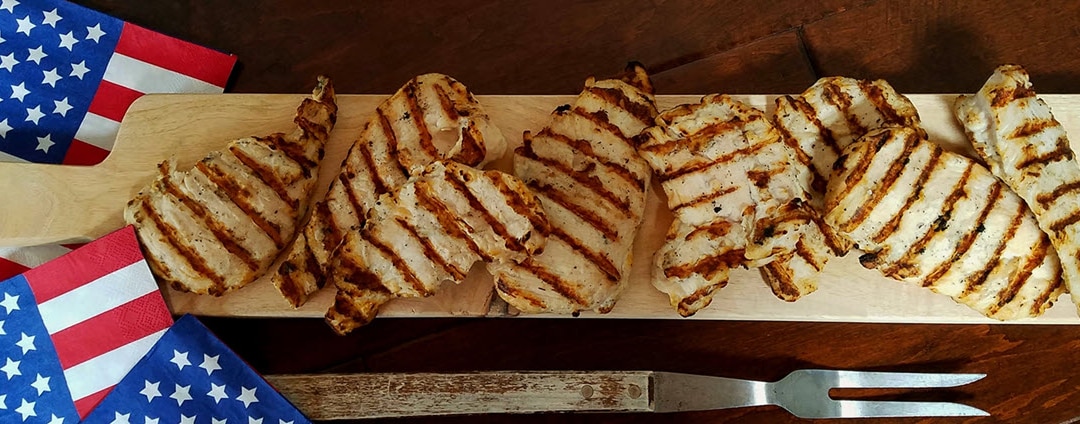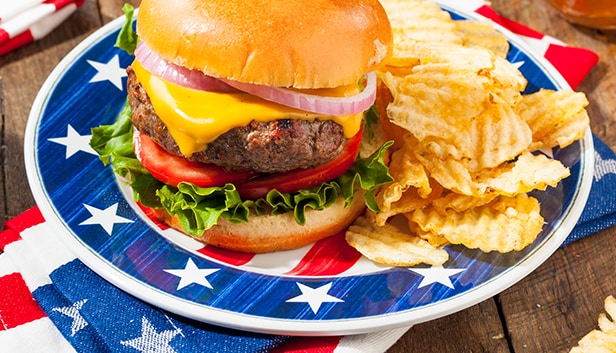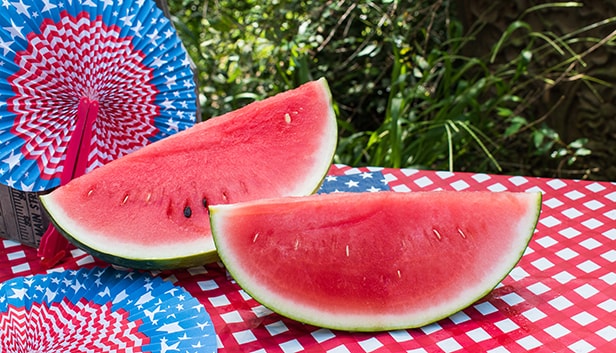Wells Fargo Fourth of July Food Report

Patriotic poultry revealed as Wells Fargo Agri-Food Institute’s top pick for Fourth of July
Party of ten expected to cost $130, with chicken serving as a prime choice for protein
Presented by Dr. Michael Swanson, Chief Agricultural Economist; Robin Wenzel, Head of Wells Fargo Agri-Food Institute; and Courtney Schmidt and Brad Rubin, Agri-Food Institute Sector Managers
On a day filled with fireworks, flags and parades, Fourth of July celebrations often center around one of America’s most cherished summer traditions: the backyard barbecue. Popularized with the development of suburban neighborhoods following World War II, the Fourth of July cookout has become a symbol of community and shared traditions. As family and friends prepare to gather in honor of Independence Day, now is the perfect time to get financially fluent on this year’s festive feast.
To help celebrants not break the bank, Wells Fargo’s Agri-Food Institute analyzed costs for hosting a classic Fourth of July gathering for 10 people, using data from NielsenIQ, which tracks food scanned at retailers across the U.S. This year, consumers can expect to pay around $130* for food and beverages (up 2.2% YOY), but as we’ve often seen, the devil is in the details. Or perhaps in this case, the deviled eggs. The all-star menu includes barbecued chicken breasts, beef sliders, hotdogs, fresh fruit, vegetable platter, potato salad, corn bread, cake, apple pie, ice cream, beer, wine, soda, and flavored sparkling waters. And with over 85% of the food consumed in the U.S. produced domestically, celebrants looking to shop U.S. products for the BBQ should find it easy.
Red, white and BBQ’d patriotic poultry and bite-size beef
Hamburgers cooked on the grill are always a crowd pleaser, but this year consumers may want to scale back as the cost of ground beef is up 7.4% over last year. Supply and demand is the issue, with the U.S. cattle herd at one of the lowest levels since the 1950’s, driving up prices due to limited supply. Budget-conscious hosts can swap out quarter-pounder patties for slider-sized burgers, or turn to more cost-effective options like hotdogs, up less than half a percent as long as shoppers steer away from all-beef hotdogs. With elevated beef prices, chicken is a top alternative, especially for those looking for a leaner protein. Boneless barbecued chicken breasts are up just 1% thanks to ample supply and lower feed costs. For those adding BBQ sauce, heads-up that this saucy staple is up 2.3%. Finally, celebrants can take the liberty of sandwiching all the grilled goodies, thanks to hamburger and hotdog bun prices dropping almost (1.5%) as retailers make downward price adjustments to stay competitive.


Seasonal, simple and star-spangled produce
Summer is peak-picking for many fresh fruits and vegetables, offering a colorful and affordable way to enhance the spread. Watermelon and strawberries are grown in abundance in the U.S., with prices down (0.6%) year-over-year providing excellent value for summer snacking. Consumers building vegetable platters will do well by stocking up on cauliflower and broccoli, only up 1.2% and baby carrots up 1.9%. And while the ever-popular cherry tomatoes are often high on shopper’s lists, these flavor-packed bites come at a cost, this year up 3.7% over last year. Shoutout to California producers for providing incredible produce enjoyed coast to coast, and hot tip for consumers to also keep an eye on farmers’ markets in local communities. There’s no better way to take advantage of the best in-season fruit and vegetable options, and it’s a great way to support and show appreciation for local farmers.
Shelling out for the sides
No Fourth of July barbeque is complete without potato salad, a classic favorite. While the spud serves as the star of the starches, up a mere 1% year-over-year, if the recipes call for hard boiled eggs, be prepared to shell out more. Egg prices have long dominated the headlines as the national bird flu outbreak has disrupted egg production and pushed prices higher. Although prices have begun to ease, they are still up considerably, in this case, 40% over the prices for the same period in 2024. If deviled eggs are a fan-favorite in your crowd, be prepared to make extra room for the additional cost.
Cornbread and barbecue go hand-in-hand and consumers looking for convenience can head straight to the bakery section at the grocery store for ready-made options. That convenience comes with a cost, and this year shoppers can expect to pay 2.4% more. To make a carb offering extra special, consider picking up some local honey while at the farmers’ market.
Sweet land of liberty
The Fourth of July is commonly known as America’s birthday, marking adoption of the Declaration of Independence in 1776. On this historic day, the thirteen American colonies declared independence from British rule, giving birth to the United States as a new sovereign nation. As friends and family gather to celebrate, no birthday can be complete without cake, ice cream and in this case, the all-American favorite: apple pie! While guests save room for dessert, expect to save, with prices for the ready-made baked goods showing little change, (up 1.5% or less) since 2024 and the cost of a 1.5-quart container of ice cream up less than 1%, making it the perfect year to go ahead and serve that second scoop.
Ending with a splash
In addition to great food, hosts will want to offer guests some relief from the July heat. Beer, wine and sodas are well-seasoned staples, while flavored sparkling waters and ready-to-drink cocktails are on-trend. Classic offerings are largely the way to go this year with beer and wine (red, white and sparkling) prices up less than 2%. Root beer and other sodas will cost a bit more than last year, you can opt to save money by selecting the large format liter bottle up just 2%, but still a savings over cans. For those looking for low- sugar, non-alcoholic options, flavored sparkling waters present excellent and popular options. Thanks to their popularity, shoppers can expect to pay 4.7% more than last year for single serve bottles in packs of eight, but keep an eye out for promotions and discounts as the competition in this category continues to grow and vie for shelf space. Consumers will pay the price for serving those ready-to-drink alcoholic beverages, and for that reason we’ve left them off the menu. This can be an excellent option for friends and family to BYOB and contribute their favorite drinks to the party and help keep costs down.
The Fourth of July remains a time to celebrate freedom, family and flavor. With a few smart swaps and seasonal choices, you can serve up a memorable feast that’s as budget friendly and domestically made as it is festive.

Dr. Michael Swanson, Chief Agricultural Economist

Robin Wenzel, Head of Wells Fargo Agri-Food Institute

Courtney Buerger Schmidt, Sector Manager

Brad Rubin, Sector Manager
Michael Swanson, Ph.D. is the Chief Agricultural Economist within Wells Fargo's Agri-Food Institute. He is responsible for analyzing the impact of energy on agriculture and strategic analysis for key agricultural commodities and livestock sectors. His focus includes the systems analysis of consumer food demand and its linkage to agribusiness. Additionally, he helps develop credit and risk strategies for Wells Fargo’s customers, and performs macroeconomic and international analysis on agricultural production and agribusiness.
Michael joined Wells Fargo in 2000 as a senior economist. Prior, he worked for Land O’ Lakes and supervised a portion of the supply chain for dairy products, including scheduling the production, warehousing, and distribution of more than 400 million pounds of cheese annually, and also supervised sales forecasting. Before Land O’Lakes, Michael worked for Cargill’s Colombian subsidiary, Cargill Cafetera de Manizales S.A., with responsibility for grain imports and value-added sales to feed producers and flour millers. Michael started his career as a transportation analyst with Burlington Northern Railway.
Michael received undergraduate degrees in economics and business administration from the University of St. Thomas, and both his master’s and doctorate degrees in agricultural and applied economics from the University of Minnesota.
Robin Wenzel is a Senior Vice President and the Head of Wells Fargo’s Agri-Food Institute, a team of national industry advisors providing economic insights, analytics, research, and reporting across the agribusiness, food, and beverage spectrum. With more than 30 years of commercial and corporate banking experience, Robin leads with a strategic vision and an ability to expand and execute on the team’s deliverables to better support Food, Beverage, and Ag customers and prospects.
Robin received her degree in Business from the University of San Francisco with an interest in Finance and International studies.
Robin has long been recognized for her work as a leading voice in the wine industry in Napa, CA. She is also a recipient of the 2017 North Bay Business Journal Women in Business Award.
Courtney Buerger Schmidt is a Sector Manager within Wells Fargo’s Agri-Food Institute focused on the protein, cotton, and hay sectors. Courtney originally joined Wells Fargo in 2014 as a relationship manager within The Private Bank Wealth Management group where she spent two years prior to assuming her current role. Before Wells Fargo, Courtney spent six years as a commodity broker and research analyst with Frontier Risk Management developing hedge and risk management strategies for Agribusiness clients, and also served as assistant director of the research division that focused on livestock, grain, and oilseed.
Courtney holds a Bachelor of Science degree in Agricultural Economics with an emphasis in finance and real estate from Texas A&M University. Courtney was recently selected for Texas Agriculture Lifetime Leadership (TALL) Cohort XVIII 2022-2024. She is also a member of the Texas A&M College of Agriculture Development Council.
Brad Rubin is a Vice President and sector manager within Wells Fargo Agri-Food Institute. Brad specifically focuses on Fruit, Vegetables, Coffee, and other Specialty Crops. Brad joined Wells Fargo in January 2018, and formerly worked as an Advisor and Chief Marketing Officer for iDTech. Prior, he held executive roles with other technology companies.
Brad's initial career was heavily focused in the digital and ecommerce sector where he worked for 20 years. Since coming to Wells Fargo, he has focused on Agriculture companies and risk assessment within the Food and Agribusiness industry vertical.
Brad holds a Bachelor of Science degree in Industrial Technology from California Polytechnic State University, San Luis Obispo. Brad lives with his wife and two kids in Templeton, CA where he spends his free time coaching sports. He is the boys varsity soccer coach at Templeton High School. Brad offices in Templeton, California where his geographic area of coverage extends to all regions of North America.
NielsonIQ, data as of May 2025
USDA, data as of May 2018 Close to 90 percent of U.S. consumers’ food and beverage spending is for domestically produced products | Economic Research Service
RO-4552119
LRC-0625

